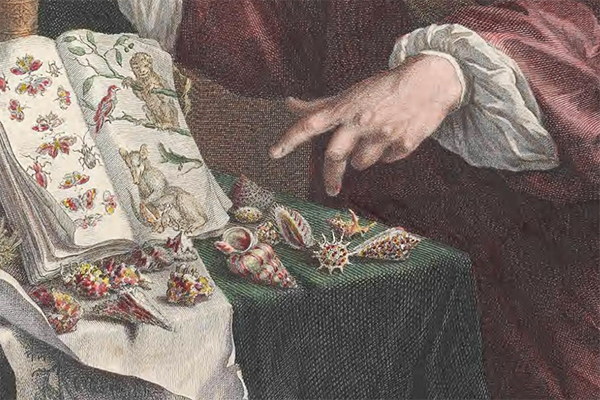
An apothecary associated with the Dutch East India Company, Albert Seba (Latinized as Albertus) had ready access to the crews of ships returning to Amsterdam, tending to the sailors and asking about any shells they might have brought back with them. Eventually, he commissioned a lavishly illustrated catalog to record the richest natural treasures in his museum. Locupletissimi rerum naturalium thesauri accurata descriptio was published in four volumes, the shells illustrated and described in Volume III. This detail is from the frontispiece to Volume I and depicts Seba pointing with evident satisfaction to several of the rarer shells, which include (from left to right) a Precious Wentletrap, Venus dione, the star-shaped Angaria sphaerula Kiener, 1839, and C. cedonulli.
The first two volumes of the Thesaurus (its more familiar title) were published in 1734 and 1735. Seba died the next year, and the final two volumes did not appear until 1758 and 1765. By then, his collection had been dispersed all over Europe, ironically having been auctioned in 1752 to defray the publishing cost of the very catalog that had popularized it.
Most editions were offered with illustrations in black and white; for example, a four-volume set that sold at Sotheby's for £84,500 in 2008. A hand-colored set sold at Christie's in 1997 for $277,500 and another in 2000 for $442,500. Although Seba had asserted in the introduction to the Thesaurus that all the specimens were from his own collection, Cedo Nulli is one example of a shell that belonged to someone else. Indeed, in an attempt to make the Thesaurus more complete, drawings of plants, animals, and insects from other collections, either loaned to Seba or copied from books already in print, were included. Remarkably, this was Seba's second cabinet of shells, the first having been sold to Peter the Great in 1717 for 15,000 florins. Thirty-five years later, Seba's second collection sold posthumously for 24,440 fl.
References: Locupletissimi rerum naturalium thesauri accurata descriptio. (1734) by Albertus Seba; A History of Shell Collecting (1986) by Peter S. Dance. The Biodiversity Heritage Library offers a number of eighteenth-century natural history online.
See also Precious Wentletrap and Venus dione.